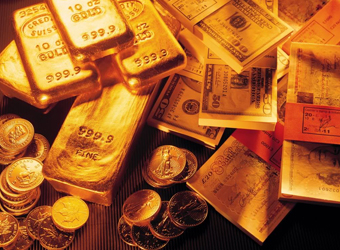Gold prices declined on Friday as the U.S. dollar ticked up against the euro after U.S. jobs data showed a robust rise in jobs and wages and 10-year U.S. Treasury yields peaked.
Spot gold dropped 1.48 percent at $1,328.91 an ounce by 3 p.m. EST, while U.S. gold futures for April delivery settled down $10.60, or 0.8 percent, at $1,337.30.
Non-farm payrolls rose by 200,000 jobs in January, the U.S. Labor Department said, beating expectation of 180,000 and their largest annual gain in more than 8-1/2 years. Average hourly earnings rose and boosted the year-on-year increase to 2.9 percent, the largest rise since June 2009.
“The hawkish reading of the data is proving to be a trigger point for more downside pressure in gold in the short-term,” said Suki Cooper, precious metals analyst at Standard Chartered Bank.
Benchmark 10-year Treasury yields extended their rise to more than 2.8 percent reaching a 4-year high after the U.S. jobs data was released.
“The fact that it’s gone up that fast that quick could force the Fed to act more aggressively before the March meeting if the 10-year gets to three percent,” said Bob Haberkorn, senior market strategist at RJO Futures.
Higher interest rates make gold less attractive to investors because it does not pay interest. The Fed held interest rates unchanged after its latest policy meeting this week but raised its inflation outlook and flagged “further gradual” rate increases.
Gold is set to end this week 1.1 percent lower, after rising in six out of the last seven weeks and hitting its highest in 17 months last week at $1,366.07.
On the wider markets, world stocks were set to post their biggest weekly drop since late 2016 as talk of central bank policy tightening and expectations of higher inflation boosted borrowing costs globally.
Holding gold offers a degree of insurance if the broader market suffers a correction, ScotiaMocatta said in a monthly report this week. “Record-setting global equities may well start to wobble if inflation starts to pick up, or if bond yields/interest rates continue to rise,” it said.
Silver dropped 3.7 percent at $16.593 an ounce after hitting $16.66, its lowest since Dec. 28. It was poised for a 3.8 percent weekly decline.
Platinum declined 1.78 percent at $987.90 per ounce, on track for a 1.6 percent weekly drop. Palladium rose 0.53 percent at $1,042.50 per ounce.
After hitting record highs this month, palladium is on track for its biggest weekly drop since early September, down 4.2 percent. Source: Reuters
Source: Reuters


